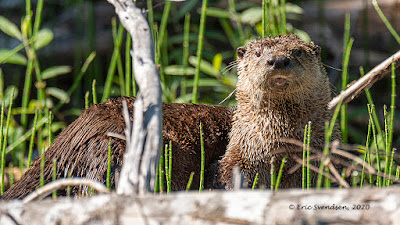North American River Otter at Silver Lake, near Hope, BC.
 |
| A River Otter enjoying a meal behind a fallen tree. |
Kayaking represents a different approach altogether. Although paddling produces noises, especially if wavy conditions allow water to lap against the sides of your craft, you can approach your quarry in something akin to stealth mode. A typical situation finds me spotting something and giving the boat a heading then coasting silently upon my goal. This is where a rudder comes in handy; a useful device but not completely necessary. Skegs or a quiet flip of the paddle work too. The water is open to the sky meaning there is lots of light. Furthermore, if you are not heading downstream, you can approach from any direction allowing the sun to be in a friendly rather than adversarial position.
I also find that many creatures will pay less attention to a structure on the water than a two-legged apparition. I have achieved successful photos in both circumstances, but have to say the results and ability to get close to the subject are better by water than by land. Of course, trails have the decided advantage of being able to take you to places where water bodies either don't exist or are impossible to put a craft upon it. So, the final truth in the matter is that I like to get out into wild places any way that I can, and will happily photograph whatever is there whether I come by sea or land. It is not unusual to try both.
I brought my equipment out to Silver Lake, a modest sized waterbody near Hope. I paddled the length and breadth of it in about an hour and a half and got off some nice landscape photos that I will talk about in another blog down the road. Near the end of my luxuriant circumnavigation, I spotted a furry lump behind a fallen tree; it was busily addressing something and took no notice of me. I was at the wrong angle to it so I paddled away and came at it from a better direction taking advantage of the sun's position. Floating along like so much vegetation, I gradually got closer, shooting photos as the distance between us reduced. When I was as close as I dared get, I marvelled at the sight for a few moments then headed back to my launch point.
The other thing I appreciate about approaching something like the otter in a boat is that I can often leave them where I found them without disturbing their peace or sense of safety. If an animal gets disturbed enough it could leave the area entirely, and during brooding season there is the risk of abandonment of the young. The more people there are and the closer they get the greater the disturbance to the wildlife of an area. Being a naturalist at heart, I would prefer for my presence not to have an adverse effect on the creatures I photograph. After all, even we don't like being followed around by paparazzi. Why would animals feel any differently?
Thanks for reading. www.ericspix.com Eric Svendsen



Comments
Post a Comment